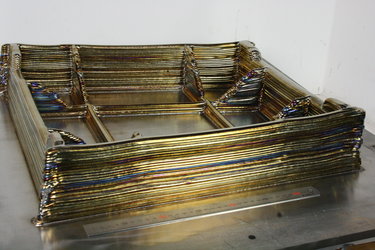Accept all cookies Accept only essential cookies See our Cookie Notice

About ESA
The European Space Agency (ESA) is Europe’s gateway to space. Its mission is to shape the development of Europe’s space capability and ensure that investment in space continues to deliver benefits to the citizens of Europe and the world.
Highlights
ESA - United space in Europe
This is ESA ESA facts Member States & Cooperating States Funding Director General Top management For Member State Delegations European vision European Space Policy ESA & EU Space Councils Responsibility & Sustainability Annual Report Calendar of meetings Corporate newsEstablishments & sites
ESA Headquarters ESA ESTEC ESA ESOC ESA ESRIN ESA EAC ESA ESAC Europe's Spaceport ESA ESEC ESA ECSAT Brussels Office Washington OfficeWorking with ESA
Business with ESA ESA Commercialisation Gateway Law at ESA Careers Cyber resilience at ESA IT at ESA Newsroom Partnerships Merchandising Licence Education Open Space Innovation Platform Integrity and Reporting Administrative Tribunal Health and SafetyMore about ESA
History ESA Historical Archives Exhibitions Publications Art & Culture ESA Merchandise Kids Diversity ESA Brand CentreLatest
Space in Member States
Find out more about space activities in our 23 Member States, and understand how ESA works together with their national agencies, institutions and organisations.
Science & Exploration
Exploring our Solar System and unlocking the secrets of the Universe
Go to topicAstronauts
Missions
Juice Euclid Webb Solar Orbiter BepiColombo Gaia ExoMars Cheops Exoplanet missions More missionsActivities
International Space Station Orion service module Gateway Concordia Caves & Pangaea BenefitsLatest
Space Safety
Protecting life and infrastructure on Earth and in orbit
Go to topicAsteroids
Asteroids and Planetary Defence Asteroid danger explained Flyeye telescope: asteroid detection Hera mission: asteroid deflection Near-Earth Object Coordination CentreSpace junk
About space debris Space debris by the numbers Space Environment Report In space refuelling, refurbishing and removingSafety from space
Clean Space ecodesign Zero Debris Technologies Space for Earth Supporting Sustainable DevelopmentLatest
Applications
Using space to benefit citizens and meet future challenges on Earth
Go to topicObserving the Earth
Observing the Earth Future EO Copernicus Meteorology Space for our climate Satellite missionsCommercialisation
ESA Commercialisation Gateway Open Space Innovation Platform Business Incubation ESA Space SolutionsLatest
Enabling & Support
Making space accessible and developing the technologies for the future
Go to topicBuilding missions
Space Engineering and Technology Test centre Laboratories Concurrent Design Facility Preparing for the future Shaping the Future Discovery and Preparation Advanced Concepts TeamSpace transportation
Space Transportation Ariane Vega Space Rider Future space transportation Boost! Europe's Spaceport Launches from Europe's Spaceport from 2012Latest
3D printing titanium for ESA’s Athena
Thank you for liking
You have already liked this page, you can only like it once!
A close-up view of laser melting being used to 3D print in titanium to produce test versions of the ‘optic bench’ at the heart of ESA’s Athena X-ray observatory. A multi-axis robotic arm is being used to produce the complex structure, including deep pockets to place optical mirror modules.
“The essential technological achievement is the fact that 3D printing takes place under local protective gas shielding, without a protective gas chamber,” comments André Seidel, overseeing the project at the Fraunhofer Institute for Material and Beam Technology in Germany.
“This is enabled by a specially-developed process head called COAXShield which uses the noble gas argon to sweep titanium powder into the path of the laser, in the process protecting the newly-printed titanium from contact with the atmosphere.”
This gas protection enables a rapid change between additive manufacturing – laser metal deposition with powder – and subtractive manufacturing – as cryogenically cooled milling tool operated by a second robotic arm removes surplus titanium.
The optic bench itself is placed on a slowly moving 3.4-m diameter turntable between the two robotic arms. The end goal of this ESA Technology Development Element project is to produce a 3-m diameter optical bench, but in principle the procedure can be applied to a wide variety of sizes.
“You can see the metallic bright surface of the titanium, reflecting the honeycomb structure of the protective gas nozzle,” adds André. “Taking account of this for laser melting was a very big challenge, and an absolute milestone in the project.”
Credit: Fraunhofer IWS
-
CREDIT
Fraunhofer IWS -
LICENCE
ESA Standard Licence
-
Closed captions available Captions and subtitles are available (automatically generated by YouTube) - select your language using the YouTube player controls. A non-YouTube version is available using the 'download' button above.
-
Close-up
-
-

3D printing and milling Athena optic bench

Ins and outs of 3D printing

Close-up of 3D-printed titanium alloy

Metal 3D-printed Ariane launcher bracket















 Germany
Germany
 Austria
Austria
 Belgium
Belgium
 Denmark
Denmark
 Spain
Spain
 Estonia
Estonia
 Finland
Finland
 France
France
 Greece
Greece
 Hungary
Hungary
 Ireland
Ireland
 Italy
Italy
 Luxembourg
Luxembourg
 Norway
Norway
 The Netherlands
The Netherlands
 Poland
Poland
 Portugal
Portugal
 Czechia
Czechia
 Romania
Romania
 United Kingdom
United Kingdom
 Slovenia
Slovenia
 Sweden
Sweden
 Switzerland
Switzerland

























